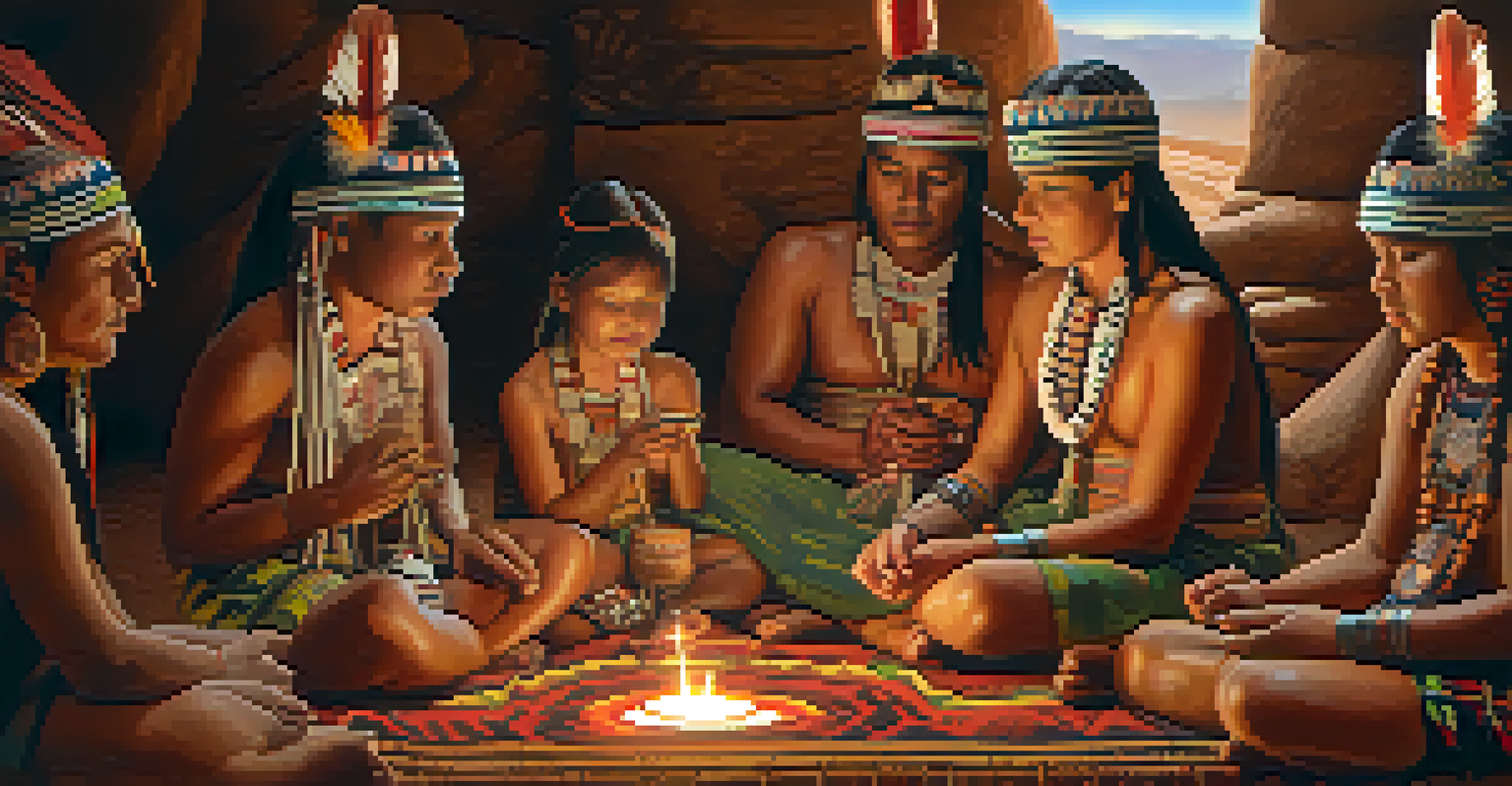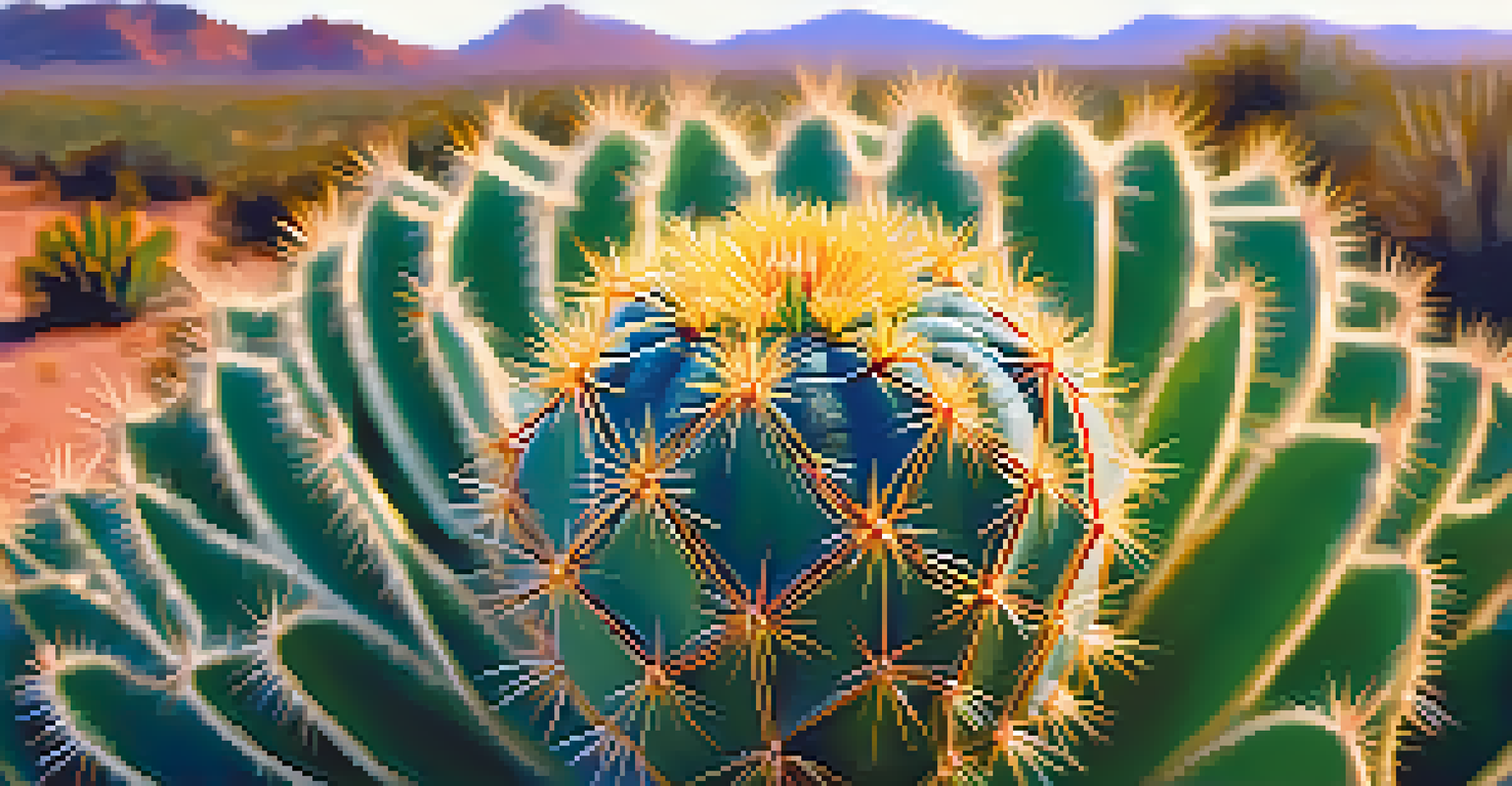The Role of Peyote in Indigenous Healing Traditions Today

Understanding Peyote: A Brief Introduction
Peyote, a small cactus native to northern Mexico and southwestern Texas, has been an integral part of Indigenous cultures for centuries. This psychoactive plant contains mescaline, a compound that induces altered states of consciousness. For many Indigenous tribes, Peyote is not just a plant; it is a spiritual guide and a vital component of traditional healing practices.
Peyote is not a drug, it is a teacher, a guide, and a bridge to the spiritual world.
The use of Peyote dates back thousands of years, with archaeological evidence suggesting its use in rituals and healing. It serves as a bridge between the physical and spiritual realms, allowing practitioners to connect deeply with their heritage and the natural world. Understanding its significance requires respect for the cultural practices that surround it.
Today, Peyote is still revered in various Indigenous communities, where it is employed in ceremonies aimed at achieving personal and communal healing. This traditional use highlights the enduring relationship between Indigenous peoples and their natural environment, emphasizing a holistic approach to health and wellness.
Peyote in Modern Indigenous Healing Practices
In contemporary Indigenous healing traditions, Peyote plays a crucial role in addressing various physical and spiritual ailments. Many healers incorporate Peyote into rituals and ceremonies, believing it helps individuals confront their issues and find clarity. This process often involves communal gatherings, fostering a sense of unity and support among participants.

During these ceremonies, participants may experience visions or insights that guide them toward healing. The collective experience not only strengthens the bonds within the community but also reinforces cultural identity. This aspect of communal healing underscores the importance of shared experiences in Indigenous cultures.
Peyote's Cultural Significance
Peyote is deeply rooted in Indigenous cultures as a sacred plant used for spiritual guidance and healing.
Moreover, Peyote ceremonies are often accompanied by songs, prayers, and storytelling, further enriching the healing process. By weaving these elements together, Indigenous healers create a holistic environment that encourages emotional and spiritual growth, emphasizing the interconnectedness of all aspects of life.
The Spiritual Significance of Peyote
Beyond its healing properties, Peyote holds profound spiritual significance for many Indigenous peoples. It is often viewed as a sacred teacher that imparts wisdom and guidance, helping individuals navigate their personal journeys. This spiritual dimension is essential to understanding why Peyote is more than just a substance; it is a pathway to deeper self-awareness.
The plant is a part of our culture, it teaches us about life and connects us to our ancestors.
Participants in Peyote ceremonies often report transformative experiences that lead to greater understanding of themselves and their place in the universe. These experiences can foster a sense of belonging and purpose, essential for mental and emotional well-being. For many, Peyote serves as a reminder of the interconnectedness of all life.
Additionally, the rituals surrounding Peyote use reinforce cultural values and teachings, passing down knowledge through generations. This blend of spirituality and tradition ensures that the lessons learned during these ceremonies remain alive and relevant in today's world.
Challenges Facing Peyote and Indigenous Practices
Despite its importance, the use of Peyote is not without challenges. Overharvesting and habitat loss have led to a decline in Peyote populations, threatening its availability for traditional ceremonies. This concern highlights the urgent need for conservation efforts and sustainable practices within Indigenous communities.
Furthermore, the legal status of Peyote varies across regions, complicating its use in healing practices. In some areas, restrictions limit access, making it difficult for Indigenous peoples to engage in their cultural traditions. These legal hurdles also raise questions about the rights of Indigenous communities to practice their beliefs freely.
Challenges to Peyote Practices
Overharvesting and legal restrictions threaten the availability and use of Peyote in traditional ceremonies.
In response to these challenges, many Indigenous leaders advocate for the protection of Peyote and the rights of their communities. By raising awareness about the importance of Peyote in healing traditions, they aim to ensure that future generations can continue to benefit from its teachings and healing properties.
The Role of Education in Preserving Peyote Traditions
Education plays a vital role in preserving the traditions surrounding Peyote and its use in healing. Many Indigenous communities are actively working to pass down knowledge about Peyote to younger generations, ensuring that cultural practices remain alive. This transmission of knowledge emphasizes the importance of understanding both the spiritual and ecological aspects of Peyote.
Workshops, ceremonies, and community gatherings provide opportunities for education and engagement. These events not only teach about the significance of Peyote but also foster respect for Indigenous cultures and their holistic approaches to health. By involving younger individuals, communities can ensure that the wisdom of Peyote is not lost.
Additionally, collaborative efforts with non-Indigenous groups can help raise awareness about the importance of conserving Peyote and supporting Indigenous rights. By fostering dialogue and understanding, these initiatives create a bridge between cultures, promoting respect and appreciation for traditional healing practices.
Contemporary Perspectives on Peyote Use
As society becomes more aware of Indigenous healing practices, there is a growing interest in Peyote and its benefits. This curiosity often leads to discussions about the cultural significance of Peyote and the importance of respecting Indigenous traditions. However, it is crucial to approach these conversations with sensitivity and an understanding of the cultural context.
Many Indigenous leaders emphasize the need for non-Indigenous individuals to recognize that Peyote is not a recreational drug but a sacred plant with deep cultural roots. Misunderstanding or misappropriating its use can lead to harmful consequences for Indigenous communities. Therefore, promoting respectful and informed dialogue is essential.
Education Preserves Peyote Traditions
Education and community engagement are essential for passing down knowledge about Peyote and its cultural importance.
Furthermore, the increasing interest in plant-based therapies has sparked debates about the ethical implications of Peyote use outside Indigenous contexts. These discussions highlight the importance of acknowledging and honoring the cultural significance of Peyote while exploring its potential benefits for broader healing practices.
The Future of Peyote in Indigenous Healing Traditions
Looking ahead, the future of Peyote in Indigenous healing traditions depends on several factors, including conservation efforts and community advocacy. As Indigenous peoples continue to assert their rights and protect their cultural heritage, the role of Peyote will likely remain central to their healing practices. This resilience is a testament to the enduring significance of Peyote in their lives.
Moreover, as more people recognize the importance of traditional knowledge, there is potential for greater collaboration between Indigenous and non-Indigenous communities. Such partnerships can foster a mutual understanding of the value of Peyote, promoting its preservation and respectful use. This collaborative spirit can lead to innovative approaches to healing and wellness.

Ultimately, the future of Peyote is intertwined with the survival of Indigenous cultures and their traditional practices. By supporting these communities and respecting their knowledge, we can help ensure that Peyote continues to play a vital role in healing for generations to come.